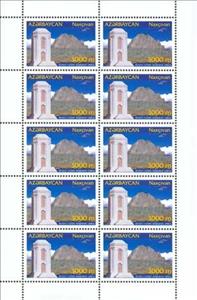Full Pane: H. Djavid Mausoleum and Hacha Mountain (Azerbaijan 2003)
H. Djavid Mausoleum and Hacha Mountain (Azerbaijan 2003)
08 April (Azerbaijan ) within release Nakhchivan goes into circulation Full Pane H. Djavid Mausoleum and Hacha Mountain face value 10*3000 Azerbaijani manat
| Full Pane H. Djavid Mausoleum and Hacha Mountain in catalogues | |
|---|---|
| Michel: | Mi: AZ 546KB |
Full Pane is vertical format.
Full Pane H. Djavid Mausoleum and Hacha Mountain it reflects the thematic directions:
Architecture (Latin architectura, from the Greek ἀρχιτέκτων arkhitekton "architect", from ἀρχι- "chief" and τέκτων "builder") is both the process and the product of planning, designing, and constructing buildings and other physical structures. Architectural works, in the material form of buildings, are often perceived as cultural symbols and as works of art. Historical civilizations are often identified with their surviving architectural achievements.
A building or edifice is a structure with a roof and walls standing more or less permanently in one place, such as a house or factory. Buildings come in a variety of sizes, shapes and functions, and have been adapted throughout history for a wide number of factors, from building materials available, to weather conditions, to land prices, ground conditions, specific uses and aesthetic reasons. Buildings serve several needs of society – primarily as shelter from weather, security, living space, privacy, to store belongings, and to comfortably live and work. A building as a shelter represents a physical division of the human habitat (a place of comfort and safety) and the outside (a place that at times may be harsh and harmful).
A mausoleum is an external free-standing building constructed as a monument enclosing the burial chamber of a deceased person or people. A mausoleum without the person's remains is called a cenotaph. A mausoleum may be considered a type of tomb, or the tomb may be considered to be within the mausoleum.



